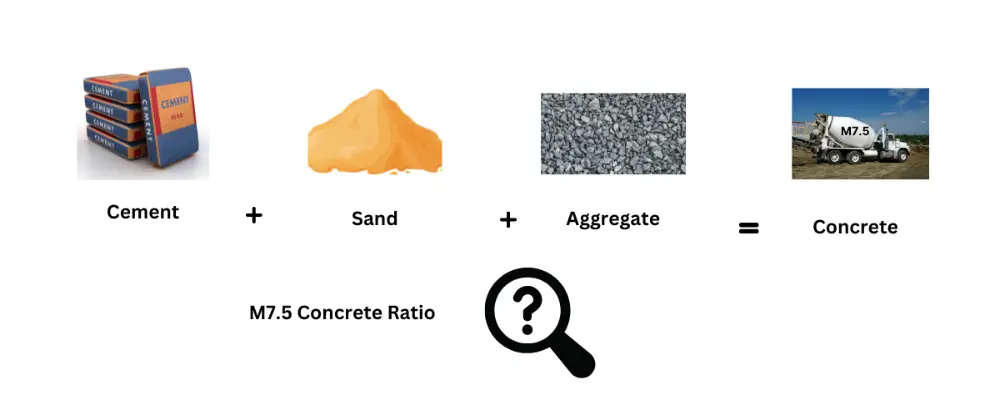Concrete is a blending of major elements, including cement, sand, water, and gravel or stone, creating a thick mixture that provides high durability and strength to the building structure. The difference in each proportion of these materials results in different grades of concrete mixtures.
Each project has its unique requirements for concrete grade. In this article, we examine the specific M7.5 concrete ratio, its components, benefits, and applications in the construction industry in detail.
What is the M7.5 Concrete Ratio?
The M7.5 concrete ratio is particularly known as the mixing ratio of the concrete in the construction process. It is the value of the cement, sand, and aggregate volumes. The standard mixing ratio of the M7.5 concrete grade is 1 part cement, 4 parts sand, and 8 parts aggregate. This can vary depending on the strength, working process, and concrete application as per project requirements.
Components of M7.5 Concrete Grade
The different components of concrete grade are explained as follows:
Cement
The binder is the major ingredient of concrete. It can be combined with other components like sand or gravel to form a powerful adhesive material.
Fine Aggregates
Sand is the most commonly used fine aggregate in construction, serving specific purposes such as plastering or concrete production. A smooth and compact surface can be achieved using these aggregates in construction projects. They are ideal for use under pavers, path fines, track fines, athletic infield material, and soil amendment.
Coarse Aggregates
The irregular granular materials may contain gravel and crushed stones that can be mixed with sand and cement to provide strength to the concrete mixture. These can be sourced naturally or through blasting in quarries. Large granular stones are crushed through crushing machines to benefit the construction and transportation processes.
Water
Water is used to form a paste with cement and other concrete materials. The water is incorporated into the concrete mixture to moisten it. Then, the mixture dries and strengthens the structure to which it is applied.
Admixtures
An admixture is a material that is used to modify the nature of the concrete mixture. This can be sourced naturally or chemically.
Use of M7.5 Concrete
The main purpose of M7.5 concrete is to support small-level construction projects, including foundations, footings, pathways, and other plain cement concrete works. Some common applications of M7.5 concrete mix are as follows:
Footings and Foundations
M7.5 concrete mix is used to build footings that are actually in contact with the ground and foundations, the superstructures that transfer the load to the earth. They are essential for building strength and structural stability.
Floor Slabs
In residential and small-rise commercial buildings, this M7.5 concrete is used to provide smooth surfaces and finishes. It lasts for a long time and ensures the strength of the floor slabs.
Paving
M7.5 concrete is sometimes used for paving pathways, sidewalks, and driveways. It offers a durable surface that withstands foot traffic and lighter vehicle loads.
Precast Concrete Elements
The premade concrete materials are manufactured using the M7.5 concrete mix. The most popular premade concrete materials include beams, columns, slabs, planks, stairs, and retaining walls. These are widely used in the construction industry to withstand tough weather conditions and provide sustainability.
Strength and Durability of M7.5 Concrete Ratio
The 28-day curing method is used to evaluate the strength of the concrete after being poured into the structure. The high compressive strength of M7.5 concrete is estimated at 7.5 MPa (N/mm²), which determines the approximate load-bearing capacity achievable with this type of concrete.
The durability of M7.5 concrete depends on the quality of the material used in the concrete mixture. It is applicable for lightweight and non-structural construction works. Some factors may affect the durability of concrete, such as the chemical composition of air, water, and soil that binds together, the proper curing process, the quality of materials used in the concrete mixture, high temperatures, and changing weather conditions.
| Concrete grade | Concrete mix ratio(cement: sand: aggregate) | Compressive strength | |
| MPa (N/mm2) | psi | ||
| M7.5 concrete grade | The mix ratio is 1:4:8. | 7.5 MPa | 1087 psi |
Factors Affecting M7.5 Concrete Quality
The quality of concrete is vital for maintaining the strength and durability of the building structure. But in some cases, it can be affected by several factors, as follows:
Water-Cement Ratio
The water-cement ratio is crucial for controlling the quality of the concrete. A minor change in this ratio will affect the workflow and nature of the concrete. For various concrete mixtures, the water-cement ratio is around 0.50.
Cement Quality
Some properties of cement may influence its performance in concrete. They are fineness, setting time, compressive strength, chemical composition, and hydration. Some popular methods, like float tests, setting time tests, etc., may help to check the quality of cement.
Curing
Proper curing ensures the optimal strength and durability of the concrete mix. It maintains the temperature level and moisture to ease the hydration process necessary to achieve strength.
Aggregate Quality
The good-quality concrete can be made using well-graded, durable, and dust-free coarse and fine aggregates.
Admixtures
Admixtures are added to modify the properties of concrete to attain strength and durability. They can impart water-resistant properties by enhancing setting, curing, hardening, and incorporating small air bubbles into the concrete mixture to increase its durability.
Conclusion
In conclusion, M7.5 concrete can be used for building moderate load-bearing structures. Small-level construction projects may use this type of concrete mixture for footings, foundations, retaining walls, floors, slabs, and other plain cement concrete works.

